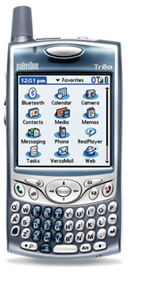 It was already pretty much certain that Palm will finally unveil its next-generation mobile operating system, along with a brand new device, at January’s Consumer Electronics Show (the press invite reads: “Come to CES to see all that Palm New-ness you’ve been waiting for”) and now BusinessWeek is stirring the pot.
It was already pretty much certain that Palm will finally unveil its next-generation mobile operating system, along with a brand new device, at January’s Consumer Electronics Show (the press invite reads: “Come to CES to see all that Palm New-ness you’ve been waiting for”) and now BusinessWeek is stirring the pot.
The opportunity
Despite the assertion that ‘Palm has protected its plans with Apple-like secrecy’, through quotes attributed to both Palm CEO, Ed Colligan, and Executive Chairman and head of product development, Jon Rubinstein, the article paints a picture of where the company appears to be heading.
New devices from Palm based on the Nova OS will target the “fat middle of the market”:
Rubinstein and others say the goal is to create products that bridge the gap between Research In Motion’s Blackberry devices, oriented to work and e-mail, and Apple’s iPhone, oriented to fun.
And while that sounds a little vague to me, there’s definitely plenty of room in the market for consumer-friendly smartphones that aren’t made by Apple. As I’m fond of saying, one size doesn’t fit all, and going out on a whim, I don’t think Palm is too late to the game — the market is expected to grow significantly over the next few years — especially if the company can deliver a user experience that is on par with devices from Cupertino. Easier said than done I know but Palm has previous form.
Engineering
Cue a quote from Mike Bell, a 16-year Apple ‘engineering star’ who joined Palm last year:
“I’m fundamentally convinced we’re onto something huge… Some of the stuff we’re working on here is mind-blowing—better than anything I’ve seen before.”
Bell is isn’t the only ex-Apple employee to be working on the new Palm either. Rubinstein himself (or “Ruby”) used to be head of hardware engineering at Apple where he helped conceive the iPod and led the team that built the original iMac. That was way back when Apple, like Palm today, found itself in dire trouble and ruled out of the game by almost everybody.
The brand
 And like Apple, I wouldn’t underestimate the power of Palm’s brand either. Despite recent years in which the company has failed to innovate, crippled by its aging OS and reliance on Windows Mobile to fill the gap, Palm is still a very recognized name. Both through its PDA ‘Palm Pilot’ legacy and the original Palm Treo that helped usher in the smartphone in the US. There are many like me whose first mobile computing experience was a Palm PDA and first smartphone with a full QWERTY keyboard was a Palm Treo not a Blackberry . Why do those products stay in such vivid memory? It’s not that they were the sexiest devices, though they were pretty cool at the time, it’s that, again like Apple with the Macintosh, they were by far the most user-friendly, creating an emotional tie that still exists to this day.
And like Apple, I wouldn’t underestimate the power of Palm’s brand either. Despite recent years in which the company has failed to innovate, crippled by its aging OS and reliance on Windows Mobile to fill the gap, Palm is still a very recognized name. Both through its PDA ‘Palm Pilot’ legacy and the original Palm Treo that helped usher in the smartphone in the US. There are many like me whose first mobile computing experience was a Palm PDA and first smartphone with a full QWERTY keyboard was a Palm Treo not a Blackberry . Why do those products stay in such vivid memory? It’s not that they were the sexiest devices, though they were pretty cool at the time, it’s that, again like Apple with the Macintosh, they were by far the most user-friendly, creating an emotional tie that still exists to this day.
Of course, nostalgia won’t be nearly enough on its own. And even if we presume that Palm’s new OS rocks and the accompanying devices are super sexy, there will still be a number of major hurdles if the company is to make a comeback.
Marketing
With only enough cash in the bank to last six quarters, I fear for Palm’s marketing budget. This is where Apple is a juggernaut, and Nokia, Microsoft and even RIM aren’t far behind either. Palm will need to be really, really smart in getting its message across as it’s unlikely to get a second go otherwise.
Attracting developers
Related to marketing will be attracting developers for Palm’s Nova OS. There’s no point creating a powerful new platform if nobody, aside from Palm, writes software for it. Again, Apple has been a runaway success here providing good developer tools for a cutting edge device, and perhaps more importantly, selling enough iPhones quickly enough to instill developer confidence that it’s worth their while. This could be Palm’s hardest challenge yet. And then there’s…
The Carriers
As the BusinessWeek article points out, ‘cash-strapped carriers are loath to take on the cost of supporting another platform’, and the mobile OS space is already seen as far too fragmented. Why back another proprietry OS, especially a new one, when there’s the much more established iPhone, Blackberry, Windows Mobile, along with open source efforts such as Android and in time Nokia’s Symbian.
However, despite these challenges, I’m backing (and rooting for) Palm to make a comeback. Although time is running out, they have the brand, the talent and a large enough opportunity to still be a player is this space. Roll on CES on January the 8th…

I’m happy to see that I’m not the only one still cheering for Palm. I have a TX, that I don’t use anymore, and I currently use a Centro. What’s wrong with enjoying something that is simple and easy to use? I take fast and function over crazy menus and crashing any day.